Despite plentiful domestically available energy resources, the energy supply in Central Asia is very unevenly distributed between urban and rural areas. Almost half of the total population of Central Asia lives in rural areas and there is a lack of access to modern energy services to meet primary needs.
- Central Asia
- energy resources
- rural energy supply
- energy services
- renewable energy
1. Introduction
1.1. Background and Context
Indicator | Kazakhstan | Turkmenistan | Uzbekistan | Kyrgyzstan | Tajikistan | ||||||||||||
|---|---|---|---|---|---|---|---|---|---|---|---|---|---|---|---|---|---|
Surface area in km2 | 2,724,902 | 488,100 | 447,400 | 199,950 | 141,380 | ||||||||||||
Population in million | 18.2 | 5.8 | 32.95 | 6.3 | 9.1 | ||||||||||||
Share of rural population in % | 43 | 43 | 50 | 64 | 73 | ||||||||||||
Gross Domestic Product in billion | USD 170 | USD 40.761 | USD 50.49 | USD 8.0 | USD 7.5 | ||||||||||||
Gross National Income/capita | USD 7970 | USD 6380 | USD 2000 | USD 1130 | USD 990 |
1.2. A Framework of Energy Resources
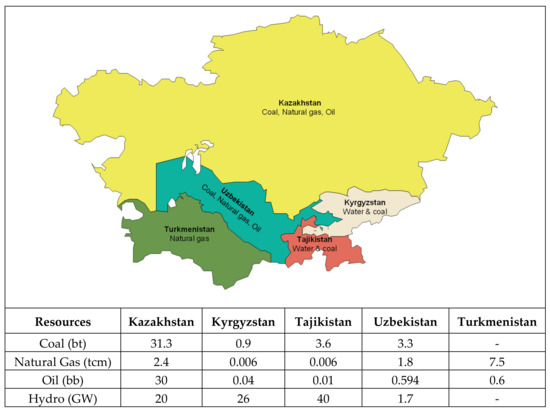
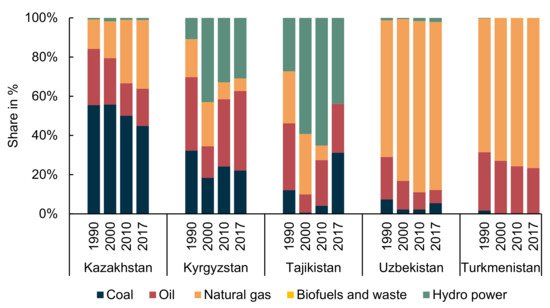
1.3. Objective and Methodology
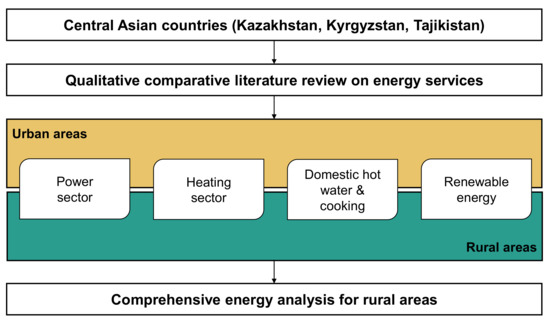
2. The Central Asian Power Sector
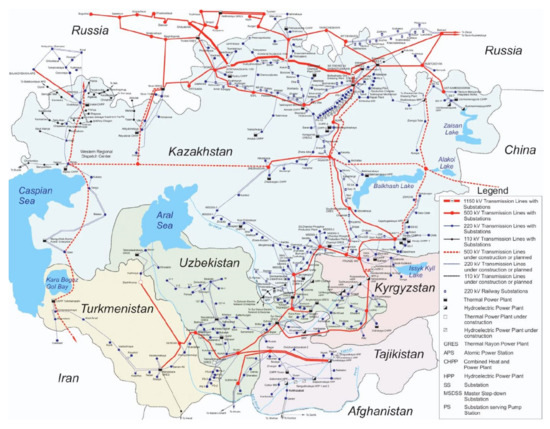
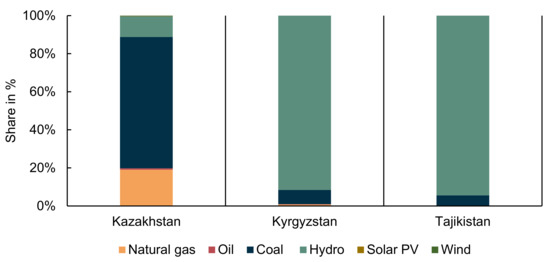
3. The Central Asian Heating Sector
Especially in the high-altitude and cold mountain Central Asian regions, more than half of the annual precipitation falls as snow during the winter (generally from November to March) [52][70]. The heating period is semi-annual in most of the Northern and Central Asian regions, resulting in around 6000 heating degree days [53][71]. Figure 6 represents the monthly air temperature of selected cities of the case study countries.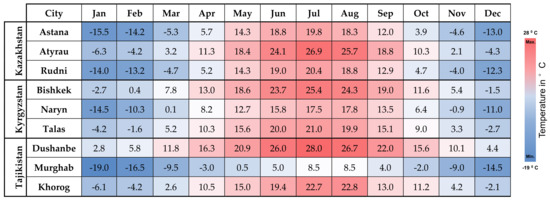

4. Hot Water Preparation and Cooking in Central Asia
4.1. Domestic Hot Water
Area | Kazakhstan | Kyrgyzstan | Tajikistan | ||||||||
|---|---|---|---|---|---|---|---|---|---|---|---|
Urban area | 78 | 85 | 93 | ||||||||
Rural area | >35 | 58 | 49 |
4.2. Cooking Methods and Fuel Sources for Cooking
5. The Potential of Renewable Energy in Central Asia and Current Trend
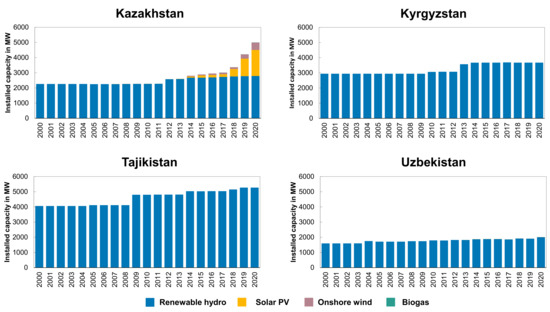
Author | Research Title | Research Aim | Key Findings | |||||||||||
|---|---|---|---|---|---|---|---|---|---|---|---|---|---|---|
Central Asia | Shardina (2020) [65] | [93] |
Non-Hydropower Renewable Energy in Central Asia: Assessment of Deployment Status and Analysis of Underlying Factors | This paper aimed to assess the reasons behind the untapped and limited development of RE sectors in Central Asian countries. | The article summarises that RE sources are distributed unevenly, and the author also suggested policy implications to improve the commitment to RE in Central Asia. | |||||||||
Nurdavletova and Akatayeva (2018) [69] | [96] |
The renewable energy in the regional development of Central Asia | The main objective of the article was to investigate the available alternative sources in Central Asia and inter-regional complexity. | The article provided a glance at the potential of the RE sector in individual countries and key hurdles in detail for the implementation of RE in Central Asian republics. | ||||||||||
Abylkasymova (2019) [76] | [103] |
Wind Power Potential of the Central Asian Countries | Theoretical wind power supply capacity as well as existing wind power installations were investigated as a key aim of the article. | Wind power has significant theoretical potential in all Central Asia countries. Over 70% of regional total wind potential is concentrated in Kazakhstan. | ||||||||||
Gubaidullina et al. (2017) [77] | [104] |
Renewable energy and the regional prospect on sustainable development of Central Asia | The paper aimed to provide useful information on the issues of renewable energy in Central Asia, as well as the insight of RE status for individual countries. | The most rapid development in the field of renewable energy is noticed in Kazakhstan and the least developed sphere of RES is in Turkmenistan. | ||||||||||
Kiseleva et al. (2017) [78] | [105] |
Efficiency estimation for the grid-tie photovoltaic stations construction in some regions of Central Asia and Transcaucasia | This techno-economic assessment evaluated the construction of network PV farm (5 MW) in selected regions of Central Asian countries. | By consideration of local feed-in tariffs, the simple payback period was determined to last 4–6 years in different regions of Central Asia for small scale PV farms (5 MW). | ||||||||||
Kazakhstan | Zavadskiy and Revalde (2020) [79] | [106] |
Problems of development of renewable energy facilities in rural regions on the example of Kazakhstan | This manuscript presents an outline of the difficulties and problems with the development of renewable energy sources in the rural regions of Kazakhstan | Kazakhstan possesses great renewable energy potential, especially in rural areas (solar, wind and bioenergy). The research article also recommends employing a special programme/policy to promote RE in Kazakhstan. | |||||||||
Vakhguelt (2017) [80] | [107] |
Renewable Energy Potential of Kazakhstan | The article presents the recent status quo of available potential of hydropower, wind power, solar power, geothermal energy, and bioenergy and their available operations in Kazakhstan. | Kazakhstan has a great potential for renewable energy production. Most of the Kazakh territory has great solar potential as well as considerable wind energy. | ||||||||||
Karatayev et al. (2016) [81] | [108] |
Renewable energy technology uptake in Kazakhstan: Policy drivers and barriers in a transitional economy | With the help of the analytical hierarchy process, this paper investigates and ranks the different barriers towards the adoption of renewable energy in Kazakhstan. Also, it provides interesting insights into the country’s legal framework. | It was identified that sustainable and affordable RE systems toned to be introduced in Kazakhstan for low carbon energy generation. Despite abundant available RE resources renewable energy currently contributes to less than 1% of the country’s power generation. | ||||||||||
Kyrgyzstan | Abidov et al. (2020) [82] | [109] |
Comparative Analysis of Some Types of Renewable Energy Sources | The article discussed the current state and possibilities of using alternative energy in Kyrgyzstan. It also assessed non-traditional renewable energy sources as well as the economic efficiency and its payback period. | The article identified that each type of RE source has its positive benefits in various regions of Kyrgyzstan. It also explained the reasons behind the insufficient use of RE in Kyrgyzstan. | |||||||||
Baybagyshov and Degembaeva (2019) [72] | [99] |
Analysis of the usage of renewable energy in Kyrgyzstan | The manuscript defined the analysis results of the opportunity of using renewable energies (Solar, wind, hydro, biomass, and geothermal) in Kyrgyzstan. | The analysis showed that the country has a great potential for renewable energy, which is unexploited. The use of renewable energy for Kyrgyzstan should be considered as a solution to population’s socio-economic problems in the decentralised high-altitude regions region. | ||||||||||
Tajikistan | Schulz et al. (2014) [83] | [110] |
The energy supply for mountain settlements in Tajikistan based on renewable energy sources | This article investigated the electrification of mountain settlements/communities of Tajikistan by means of combined forms of renewable energy sources (i.e., a small hybrid hydropower station, small PV station). | The article claimed that there is an immediate need to solve the seasonal deficiency of the Tajik power sector. It suggests that a small-scale hybrid power station operated by combined RE sources will be suitable for sustainable electricity supply for remote settlements in Tajikistan. | |||||||||
Doukas et al. (2012) [84] | [111] |
Promoting renewables in the energy sector of Tajikistan | The document presented multi-dimensional approach to identify the suitability of decentralised heat production in Tajikistan. | Technically, a low-pressure solar water heater is a more suitable design for Tajikistan. Also, the paper identified the hurdles for further development of decentralised heat production. |
